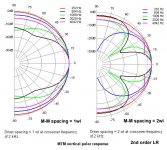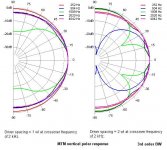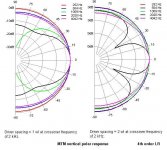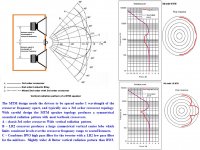I’m interested in the Aviatrix kit from parts express which comes with its own crossover parts and design:
AviaTrix-RST MTM Components Only Speaker Kit Pair
I’d like to use this kit as the top end of a large floor speaker with an 8” woofer and a (possibly powered) 12” subwoofer. Is the kit crossover (design or parts) going to be of any use to me of should I just buy the drivers and start the XO design from scratch?
AviaTrix-RST MTM Components Only Speaker Kit Pair
I’d like to use this kit as the top end of a large floor speaker with an 8” woofer and a (possibly powered) 12” subwoofer. Is the kit crossover (design or parts) going to be of any use to me of should I just buy the drivers and start the XO design from scratch?
In room responce for your sub bass may dictate better placement for your sub than under your main speakers 
Why don't you measure?
Realisticly, making ANY changes to a design can completely alter its sound. What you are thinking of doing seems rather counter productive. I would either go with a different design, or just play around with your subs
The easiest way to go would be to just mount the aviatrix on top of a couple subwoofers, then play around from there with timing and eqing of the subs.
Why don't you measure?
Realisticly, making ANY changes to a design can completely alter its sound. What you are thinking of doing seems rather counter productive. I would either go with a different design, or just play around with your subs
The easiest way to go would be to just mount the aviatrix on top of a couple subwoofers, then play around from there with timing and eqing of the subs.
Last edited:
I’d like to use this kit as the top end of a large floor speaker with an 8” woofer and a (possibly powered) 12” subwoofer.
I suggest you buy the whole thing and get some tops first. Subwoofers work better when done actively, due to the processing (EQ) and time alignment (delay) related freedom that comes out of having a separate amplifier channel. Besides, passive crossovers also dissipate a part of the energy supplied by the amplifier as heat.
In room responce for your sub bass may dictate better placement for your sub than under your main speakers
Why don't you measure?
Realisticly, making ANY changes to a design can completely alter its sound. What you are thinking of doing seems rather counter productive. I would either go with a different design, or just play around with your subs
The easiest way to go would be to just mount the aviatrix on top of a couple subwoofers, then play around from there with timing and eqing of the subs.
The choice to put the subs in the tower is mostly a style/WAF decision. I actually have a separate sub for more reinforcement as well.
As far as measurement: I don’t have any of that equipment or know anything about how to do it, but I guess I’m gonna have to learn.
I suggest you buy the whole thing and get some tops first. Subwoofers work better when done actively, due to the processing (EQ) and time alignment (delay) related freedom that comes out of having a separate amplifier channel. Besides, passive crossovers also dissipate a part of the energy supplied by the amplifier as heat.
I was kind of leaning towards active subs anyway, so I may just be trying to add a 8 inch woofer to the aviatrix design. Does that mean the XO components included will be worthless since I need a whole different XO layout and I should just buy the drivers and start with a clean slate?
Also should that 8” woofer have a high pass filter on it since there’ll be a sub below it?
The kit you linked comes with this woofer: Dayton Audio ND140-8 5-1/4" Aluminum Cone Midbass Neo Driver 8 Ohm
Looking at the specs:
Looking at the specs:
Resonant Frequency (Fs) 56.5Hz
Total Q (Qts) 0.68
Compliance Equivalent Volume (Vas) 0.27ft³
I think the best thing to do is to use this with a 12" subwoofer, and leave the 8" woofer out altogether.Total Q (Qts) 0.68
Compliance Equivalent Volume (Vas) 0.27ft³
Suggest T-M-W. If you want an 8" woofer, then find a good 3-way design with a sealed 6" midrange plus a good 8" woofer for your room. If you plan for a subwoofer, then a sealed 8" woofer should also be considered... superior transients. The SB-Acoustics aluminum cone drivers are popular. The SPL of a 4-ohm woofer often works with a 8-ohm 6" midrange.
A T-M has better polar response than a M-T-M when M is larger than 4".
A T-M has better polar response than a M-T-M when M is larger than 4".
Suggest T-M-W. If you want an 8" woofer, then find a good 3-way design with a sealed 6" midrange plus a good 8" woofer for your room. If you plan for a subwoofer, then a sealed 8" woofer should also be considered... superior transients. The SB-Acoustics aluminum cone drivers are popular. The SPL of a 4-ohm woofer often works with a 8-ohm 6" midrange.
A T-M has better polar response than a M-T-M when M is larger than 4".
Thanks for that info. I’ll look into that.
MTM vertical dispersion controls the floor and ceiling reflections very well, and this is good if your room is not treated.
However, they contain vertical nulls in the crossover region, due to the insufficient CTC between the two LFs. This problem was addressed (and also alleviated) by Charles Hughes in 2008. You may read Hughes paper here.
With smaller drivers like 4" or lesser, it only becomes easier to get smaller CTC distances and that only makes things less severe. However, properly adding another 8" to the whole contraption would be a difficult thing to do. Adding active subwoofers would be the most straightforward thing you could do.
However, they contain vertical nulls in the crossover region, due to the insufficient CTC between the two LFs. This problem was addressed (and also alleviated) by Charles Hughes in 2008. You may read Hughes paper here.
With smaller drivers like 4" or lesser, it only becomes easier to get smaller CTC distances and that only makes things less severe. However, properly adding another 8" to the whole contraption would be a difficult thing to do. Adding active subwoofers would be the most straightforward thing you could do.
Where did you read about 'droop', what is it?I’ve read that MTM has better for vertical polar response (it doesn’t suffer from droop),
What would be 'well'?MTM vertical dispersion controls the floor and ceiling reflections very well,
This popular birotechnology paper provides MTM insights.
Biro Technology
---------
The type of crossover cicuit used in an MTM also has a large affect on polar response.
Biro Technology
---------
The type of crossover cicuit used in an MTM also has a large affect on polar response.
Attachments
What would be 'well'?
A narrow vertical dispersion is good if the user has no plans to treat the floor and ceiling. It's a general statement that mainly applies to an MTM with a horn rather than a tweeter.
Yes, the problem addressed by the Hughes paper in #11 is clearly explained in this paper. Note that this paper came way back in 1996 with the Hughes paper appearing only in 2008.LineSource said:This popular birotechnology paper provides MTM insights.
And yes, the crossover has a lot to do with the radiation pattern put out by the speaker. The following are MTM verticals for different crossover types and CTC distances. I got these pictures off another forum (don't remember which) sometime ago. Hope it helps.



There is more than one way to do an MTM, and some ways don't have this effect.It's a general statement that mainly applies to an MTM
- Status
- This old topic is closed. If you want to reopen this topic, contact a moderator using the "Report Post" button.
- Home
- Loudspeakers
- Multi-Way
- Making a 2 way kit into a 3 or 4 way?
